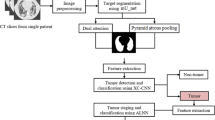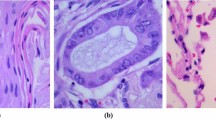Abstract
Precisely distinguishing between malignant and benign lung tumors is pivotal for suggesting therapeutic strategies and enhancing prognosis, yet this differentiation remains a daunting task. The growth rates, metastatic potentials, and prognoses of benign and malignant tumors differ significantly. Developing specialized treatment protocols tailored to various tumor types is essential for enhancing patient survival outcomes. Employing laser-induced breakdown spectroscopy (LIBS) in conjunction with a deep learning methodology, we attained a high-precision differential diagnosis of malignant and benign lung tumors. First, LIBS spectra of malignant tumors, benign tumors, and normal tissues were collected. The spectra were preprocessed and Z score normalized. Then, the intensities of the Mg II 279.6, Mg I 285.2, Ca II 393.4, Cu II 518.3, and Na I 589.6 nm lines were analyzed in the spectra of the three tissues. The analytical results show that the elemental lines have different contents in the three tissues and can be used as a basis for distinguishing between the three tissues. Finally, the RF-1D ResNet model was constructed by combining the feature importance assessment method of random forest (RF) and one-dimensional residual network (1D ResNet). The classification accuracy, precision, sensitivity, and specificity of the RF-1D ResNet model were 91.1%, 91.6%, 91.3%, and 91.3%, respectively. And the model demonstrates superior performance with an area under the curve (AUC) value of 0.99. The above results show that combining LIBS with deep learning is an effective way to diagnose malignant and benign tumors.
Graphical abstract











Similar content being viewed by others
References
Li N, Tan F, Chen W, Dai M, Wang F, Shen S, Tang W, Li J, Yu Y, Cao W, Xu Y, Qin C, Zhao L, Zhu M, Guo L, Wu Z, Yang Z, Zheng Y, Chen H, Liu Y, Wei D, Dong D, Cao J, Zhang S, Yan S, Wang N, Du L, Shen H, Wu N, He J, Cao J, Cao S, Cao W, Chen H, Chen W, Cheng Y, Cui H, Dai M, Dong D, Dong H, Dong X, Du L, Ge L, Gong J, Guo L, He J, He M, He Y, Huang L, Huang Y, Huang Y, Huang Y, Jiang J, Jin S, Kong Y, Li F, Li J, Li J, Li N, Li X, Liao X, Liu Y, Liu Y, Luo Z, Lv Z, Ma H, Ma Y, Qiao L, Qin C, Ren J, Shen H, Shen S, Shi J, Song B, Song B, Song S, Su K, Sun G, Tan F, Tang W, Wang F, Wang L, Wang N, Wei D, Wei L, Wei Q, Wen Y, Wu N, Wu Z, Xi Y, Xu Y, Yan S, Yang L, Yang Z, Yin Z, Yu L, Yu X, Yu Y, Zhang M, Zhang S, Zhang Y, Zhao L, Zheng Y, Zhou B, Zhou J, Zhu C, Zhu M, Zou K. One-off low-dose CT for lung cancer screening in China: a multicentre, population-based, prospective cohort study. Lancet Respir Med. 2022;10:378–91. https://doi.org/10.1016/S2213-2600(21)00560-9.
Xia C, Dong X, Li H, Cao M, Sun D, He S, Yang F, Yan X, Zhang S, Li N, Chen W. Cancer statistics in China and United States, 2022: profiles, trends, and determinants. Chin Med J. 2022;135:584–90. https://doi.org/10.1097/CM9.0000000000002108.
Li J, Sina AAI, Antaw F, Fielding D, Möller A, Lobb R, Wuethrich A, Trau M. Digital decoding of single extracellular vesicle phenotype differentiates early malignant and benign lung lesions. Adv Sci. 2023;10:2204207. https://doi.org/10.1002/advs.202204207.
Patel A. Benign vs malignant tumors. JAMA Oncol. 2020;6:1488. https://doi.org/10.1001/jamaoncol.2020.2592.
Luo X, Zang X, Yang L, Huang J, Liang F, Rodriguez-Canales J, Wistuba II, Gazdar A, Xie Y, Xiao G. Comprehensive computational pathological image analysis predicts lung cancer prognosis. J Thorac Oncol. 2017;12:501–9. https://doi.org/10.1016/j.jtho.2016.10.017.
Fu Z, Li D, Deng C, Zhang J, Bai J, Li Y, Chen H, Zhang Y. Excellent survival of pathological N0 small cell lung cancer patients following surgery. Eur J Med Res. 2023;28:91. https://doi.org/10.1186/s40001-023-01044-3.
Onozato Y, Iwata T, Uematsu Y, Shimizu D, Yamamoto T, Matsui Y, Ogawa K, Kuyama J, Sakairi Y, Kawakami E, Iizasa T, Yoshino I. Predicting pathological highly invasive lung cancer from preoperative [18F]FDG PET/CT with multiple machine learning models. Eur J Nucl Med Mol Imaging. 2023;50:715–26. https://doi.org/10.1007/s00259-022-06038-7.
Bradley SH, Abraham S, Callister ME, Grice A, Hamilton WT, Lopez RR, Shinkins B, Neal RD. Sensitivity of chest X-ray for detecting lung cancer in people presenting with symptoms: a systematic review. Br J Gen Pract. 2019;69:e827–35. https://doi.org/10.3399/bjgp19X706853.
Foley RW, Nassour V, Oliver HC, Hall T, Masani V, Robinson G, Rodrigues JCL, Hudson BJ. Chest X-ray in suspected lung cancer is harmful. Eur Radiol. 2021;31:6269–74. https://doi.org/10.1007/s00330-021-07708-0.
Manser RL. Lung cancer screening: screening frequency and lung cancer risk. Transl Cancer Res. 2016;5:S1227–S1232. https://doi.org/10.21037/tcr.2016.11.63.
Kirshenboim Z, Dan Lantsman C, Appel S, Klug M, Onn A, Truong MT, Marom EM. Magnetic resonance imaging for prospective assessment of local recurrence of non-small cell lung cancer after stereotactic body radiation therapy. Lung Cancer. 2023;182: 107265. https://doi.org/10.1016/j.lungcan.2023.107265.
Yang G, Xiao Z, Tang C, Deng Y, Huang H, He Z. Recent advances in biosensor for detection of lung cancer biomarkers. Biosens Bioelectron. 2019;141: 111416. https://doi.org/10.1016/j.bios.2019.111416.
Pisapia P, Pepe F, Baggi A, Barberis M, Galvano A, Gristina V, Mastrilli F, Novello S, Pagni F, Pasini S, Perrone G, Righi D, Russo A, Troncone G, Malapelle U. Next generation diagnostic algorithm in non-small cell lung cancer predictive molecular pathology: the KWAY Italian multicenter cost evaluation study. Crit Rev Oncol Hematol. 2022;169: 103525. https://doi.org/10.1016/j.critrevonc.2021.103525.
Kumar A, Yueh F-Y, Singh JP, Burgess S. Characterization of malignant tissue cells by laser-induced breakdown spectroscopy. Appl Opt. 2004;43:5399. https://doi.org/10.1364/AO.43.005399.
Han JH, Moon Y, Lee JJ, Choi S, Kim Y-C, Jeong S. Differentiation of cutaneous melanoma from surrounding skin using laser-induced breakdown spectroscopy. Biomed Opt Express. 2016;7:57. https://doi.org/10.1364/BOE.7.000057.
Ghasemi F, Parvin P, Hosseini Motlagh NS, Amjadi A, Abachi S. Laser induced breakdown spectroscopy and acoustic response techniques to discriminate healthy and cancerous breast tissues. Appl Opt. 2016;55:8227. https://doi.org/10.1364/AO.55.008227.
El-Hussein A, Kassem AK, Ismail H, Harith MA. Exploiting LIBS as a spectrochemical analytical technique in diagnosis of some types of human malignancies. Talanta. 2010;82:495–501. https://doi.org/10.1016/j.talanta.2010.04.064.
Chu Y, Chen T, Chen F, Tang Y, Tang S, Jin H, Guo L, Lu YF, Zeng X. Discrimination of nasopharyngeal carcinoma serum using laser-induced breakdown spectroscopy combined with an extreme learning machine and random forest method. J Anal At Spectrom. 2018;33:2083–8. https://doi.org/10.1039/C8JA00263K.
Winnand P, Ooms M, Heitzer M, Lammert M, Hölzle F, Modabber A. Real-time detection of bone-invasive oral cancer with laser-induced breakdown spectroscopy: a proof-of-principle study. Oral Oncol. 2023;138: 106308. https://doi.org/10.1016/j.oraloncology.2023.106308.
Yin P, Hu B, Li Q, Duan Y, Lin Q. Imaging of tumor boundary based on multielements and molecular fragments heterogeneity in lung cancer. IEEE Trans Instrum Meas. 2021;70:1–7. https://doi.org/10.1109/TIM.2021.3102755.
Lin X, Sun H, Gao X, Xu Y, Wang Z, Wang Y. Discrimination of lung tumor and boundary tissues based on laser-induced breakdown spectroscopy and machine learning. Spectrochim Acta Part B. 2021;180: 106200. https://doi.org/10.1016/j.sab.2021.106200.
Yu J, Zhou X. One-dimensional residual convolutional autoencoder based feature learning for gearbox fault diagnosis. IEEE Trans Ind Inf. 2020;16:6347–58. https://doi.org/10.1109/TII.2020.2966326.
Liu Z, Guo B, Wu F, Han T, Zhang L. An improved burr size prediction method based on the 1D-ResNet model and transfer learning. J Manuf Process. 2022;84:183–97. https://doi.org/10.1016/j.jmapro.2022.09.060.
Dong L, Wang C, Yang G, Huang Z, Zhang Z, Li C. An improved ResNet-1d with channel attention for tool wear monitor in smart manufacturing. Sensors. 2023;23:1240. https://doi.org/10.3390/s23031240.
Teng G, Wang Q, Zhang H, Xiangli W, Yang H, Qi X, Cui X, Idrees BS, Wei K, Khan MN. Discrimination of infiltrative glioma boundary based on laser-induced breakdown spectroscopy. Spectrochim Acta Part B. 2020;165: 105787. https://doi.org/10.1016/j.sab.2020.105787.
Gondal MA, Aldakheel RK, Almessiere MA, Nasr MM, Almusairii JA, Gondal B. Determination of heavy metals in cancerous and healthy colon tissues using laser induced breakdown spectroscopy and its cross-validation with ICP-AES method. J Pharm Biomed Anal. 2020;183: 113153. https://doi.org/10.1016/j.jpba.2020.113153.
Khaliq MA, James B, Chen YH, Ahmed Saqib HS, Li HH, Jayasuriya P, Guo W. Uptake, translocation, and accumulation of Cd and its interaction with mineral nutrients (Fe, Zn, Ni, Ca, Mg) in upland rice. Chemosphere. 2019;215:916–24. https://doi.org/10.1016/j.chemosphere.2018.10.077.
Orrenius S, Burkitt MJ, Kass GEN, Dypbukt JM, Nicotera P. Calcium ions and oxidative cell injury. Ann Neurol. 1992;32:S33–42. https://doi.org/10.1002/ana.410320708.
Zoroddu MA, Aaseth J, Crisponi G, Medici S, Peana M, Nurchi VM. The essential metals for humans: a brief overview. J Inorg Biochem. 2019;195:120–9. https://doi.org/10.1016/j.jinorgbio.2019.03.013.
Huang Y, Liu X, Wang L, Li S, Verbeken E, De Scheerder I. Long-term biocompatibility evaluation of a novel polymer-coated stent in a porcine coronary stent model. Coron Artery Dis. 2003;14:401–8. https://doi.org/10.1097/01.mca.0000084940.36114.94.
Zuliani V, Amori L, Rivara M. Advances in design and development of sodium channel blockers. In: Gupta SP, editor. Ion channels and their inhibitors. Berlin, Heidelberg: Springer Berlin Heidelberg; 2011. p. 79–115.
Funding
This work was supported by the Department of Science and Technology of Jilin Province of China (Grant No. YDZJ202301ZYTS481, Grant No. 20220201032GX, and Grant No. 20230402068GH), and National Natural Science Foundation of China (NSFC, No. 51374040).
Author information
Authors and Affiliations
Contributions
Jingjun Lin: methodology, writing—original draft, data curation. Yao Li: writing—original draft, writing—review and editing, data curation. Xiaomei Lin: supervision, project administration. Changjin Che: supervision.
Corresponding authors
Ethics declarations
Conflict of interest
The authors declare no competing interests.
Additional information
Publisher's Note
Springer Nature remains neutral with regard to jurisdictional claims in published maps and institutional affiliations.
Rights and permissions
Springer Nature or its licensor (e.g. a society or other partner) holds exclusive rights to this article under a publishing agreement with the author(s) or other rightsholder(s); author self-archiving of the accepted manuscript version of this article is solely governed by the terms of such publishing agreement and applicable law.
About this article
Cite this article
Lin, J., Li, Y., Lin, X. et al. Fusion of laser-induced breakdown spectroscopy technology and deep learning: a new method to identify malignant and benign lung tumors with high accuracy. Anal Bioanal Chem 416, 993–1000 (2024). https://doi.org/10.1007/s00216-023-05089-5
Received:
Revised:
Accepted:
Published:
Issue Date:
DOI: https://doi.org/10.1007/s00216-023-05089-5




